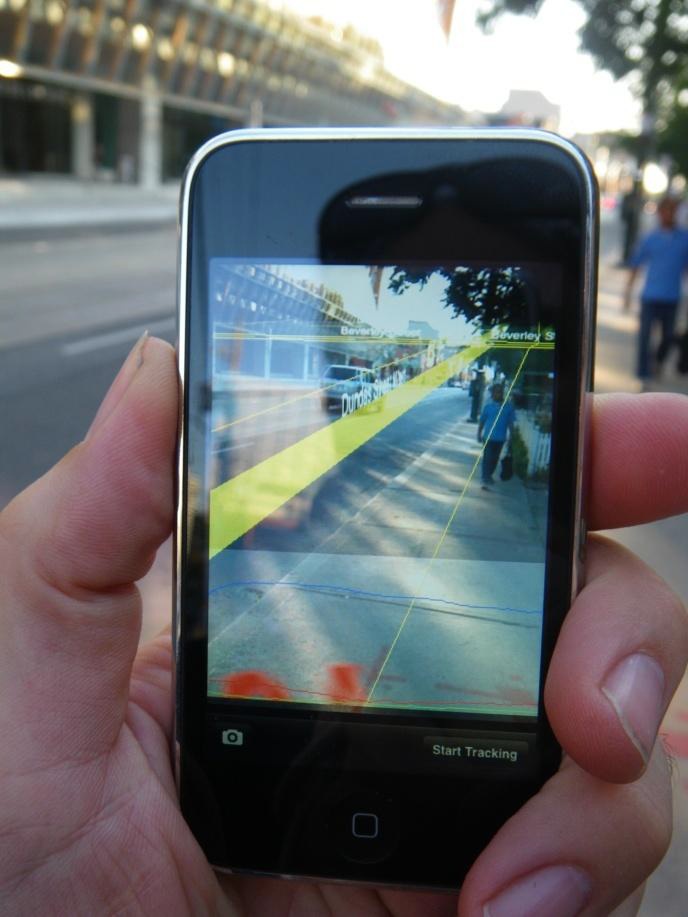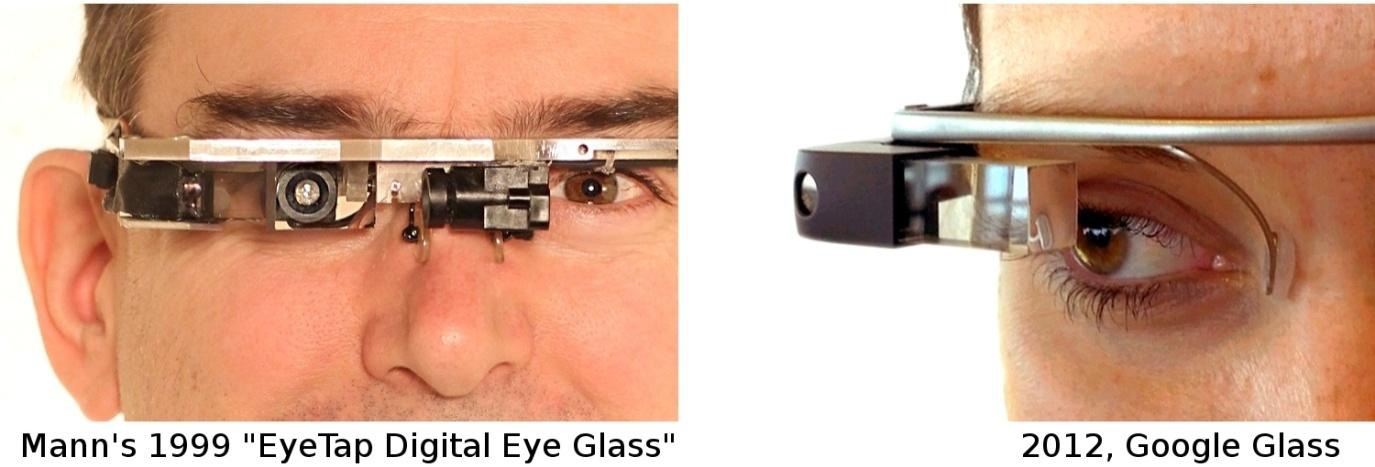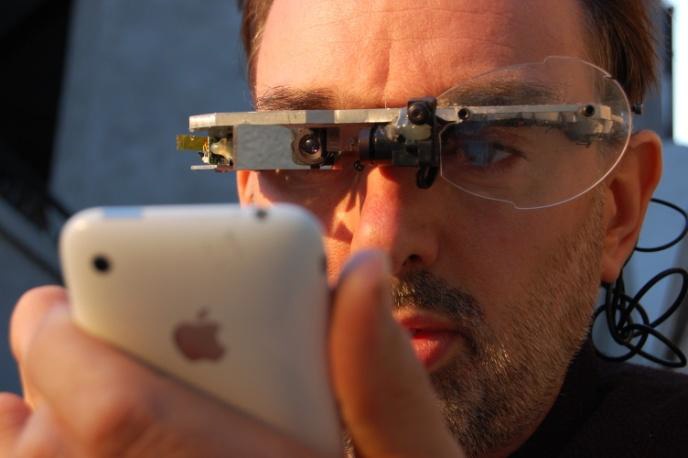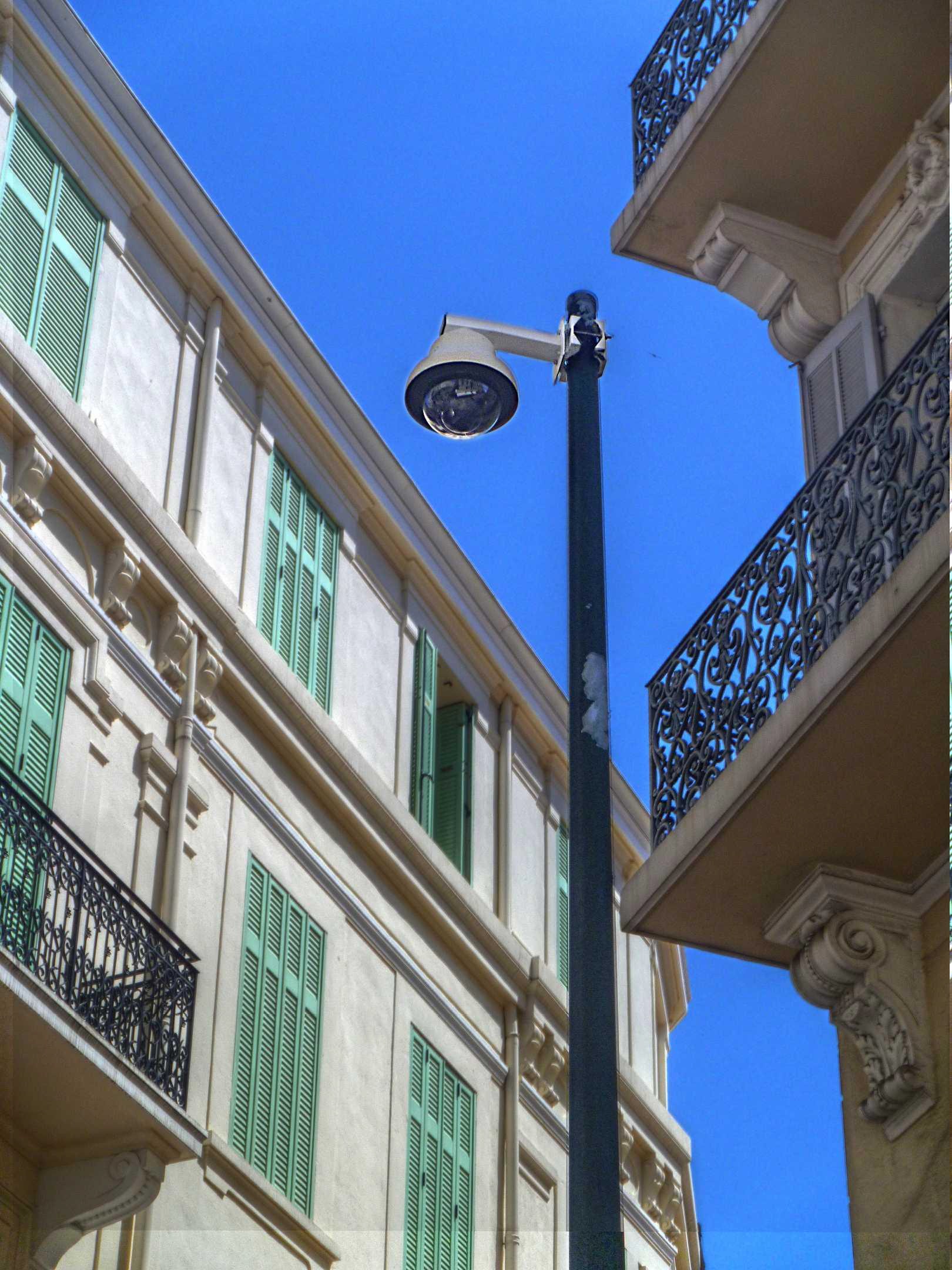The following is a guest post by Professor Steve Mann. Read Mann’s complete bio at the end of this article for more information.
Digital eye glasses like Google’s Project Glass, and my earlier Digital Eye Glass, will transform society because they introduce a two-sided surveillance and sousveillance.
Not only will authorities and shops be watching us and recording our comings and goings (surveillance as we know it today), but we will also be watching and recording them (sousveillance) through small wearable computers like Digital Eye Glass. This affects secrecy, not just privacy. As one of the early inventors and developers of wearable computing and reality augmenting and mediating, I was asked by TIME Tech to write about the history and future predictions of these technologies.
Through the Glass
Society has entered the era of augmented and augmediated reality. Most of us use smartphones, which are, in some sense, wearable computers. Many smartphone apps overlay information onto the real world and this is a good example of augmented reality. Augmediated reality serves to both augment and mediate our surroundings. For example, here’s what the street in front of my house looks like through an iPhone running Glogger.mobi:

Cell phone view, augmediated reality on iPhone
Soon, the smartphone will become eyeglass-based so that these overlays can augment and mediate our everyday lives. Companies like Google and Apple will soon be bringing out products for wearable computing in everyday life. The intended purpose of these products is the hands-free displaying of information currently available to most smartphone users. The small screen on the glass flashes information right on cue which, for instance, allows the eye glass wearer to get directions in the city, find a book in a store and even videoconference with a friend. Two examples are shown below:

This is something I’d already developed in my lab many years ago:

Mann’s Digital Eye Glass (completed in 1999) pictured here on July 13, 2009
My own engagement in this evolutionary process began way back in the last century in 1978. Thirty four years ago, I invented a “glass” that caused the human eye itself to effectively become both an electronic camera and a television display. I used it to experiment with ways to help people see better, through “wearable computing” in everyday life. I called this invention “Digital Eye Glass” or “Eye Glass” or “Glass Eye” (people wearing it look like they have a glass eye) or just “Glass” for short.
Back in 1978, computers were massive machines requiring large computer rooms. My high school had a computer. It processed stacks of paper cards and printed the results on paper in the next room.
But the personal computer revolution was just being born. My brother and I were the first in our school to have a home computer. And rather than have it sitting on a desk at home, I often wore it on my body, connected to various prototypes of my eye glass.
Eye Am a Camera: The Existential Computer
In some sense, I chose to learn about computing by “being” a computer, and to learn about photography by “being” a camera for more than 30 years. I call this “learn-by-being.”
As a teenager in the 1970s, I built a computer-mediated world of “augmediated reality”. This was nothing like “virtual reality,” which ignores the real world. Augmediated reality served to both augment and mediate my surroundings.
My “glass” became so much a part of my everyday life that it became part of me — part of my mind and body. And it evolved from a cumbersome apparatus with some parts permanently attached (portions of its sensory network implanted beneath the skin) to something sleek and slender that slides on and off like ordinary eyeglass frames. See the figure below:

The name “Steve” was common in my high school, so the other kids called me “Computer Steve” to distinguish me from the other Steves. It’s rather funny that more than 30 years ago people thought I was strange walking around with a computer in my everyday life. Now people think you are strange if you do not walk around with a computer (for example, a smartphone of some kind). I’m not the only one wearing digital eye glasses anymore. This technology is entering the mainstream.
The concept of visually-mediated reality goes back a long way, from George Stratton’s week-long upside-down glasses experiment in 1896, to early depictions in science fiction. David Brin’s 1989 novel Earth portrayed characters using “tru-vu goggles” that paint information across the real world. Vernor Vinge’s 2006 novel Rainbow’s End depicts a future youth culture that views “mere reality” as something nakedly primitive, robbed of meaning or context.
Opposition from Authorities and Shops
In my high school days, the opposition to my technology was mostly due to peer pressure — simply to its overall strangeness in being ahead of its time. But now that this peer pressure is in fact reversed (individual people want this now), a new kind of opposition is emerging. This opposition comes not from peers, but from authorities and shops. The very authorities that are installing surveillance cameras on buildings and light posts are afraid of cameras being installed on people. For example, I was wearing my Digital Eye Glass while eating at McDonald’s and was suddenly physically assaulted by McDonald’s employees. See “Physical assault by McDonald’s for wearing Digital Eye Glass.” They claimed they were enforcing (as vigilantes perhaps), a privacy law that does not even exist. See their side of the story in “Computerized seeing aids forbidden in McDonald’s.”
Although not a recording device, in the presence of such an attack, damage to the device causes it to retain temporarily stored data that would have otherwise been overwritten. In this sense the perpetrators of the attack have made what would otherwise not have been a recording device into one.
Ironically, the very establishments that oppose wearable cameras are usually the places where lots of surveillance is used. Thus I coined the new word “McVeillance” to denote a highly mass-produced (“McDonaldized”) form of veillance, in the same way that a “McMansion” is a mass-produced mansion. McVeillance also implies a prohibition on individual veillance; for example, a prohibition on what we call “sousveillance”. The term “sousveillance” stems from the contrasting French words sur, meaning “above”, and sous, meaning “below”. So “surveillance” denotes the “eye-in-the-sky” watching from above, whereas “sousveillance” denotes bringing the camera or other means of observation down to human level, either physically (mounting cameras on people rather than on buildings), or hierarchically (ordinary people doing the watching, rather than higher authorities, large entities or architectures doing the watching).
Thus, McVeillance, for example, is the installation of a large number of security cameras in a restaurant while at the same time physically assaulting guests for using their own camera to photograph the menu.
Predictions for the Future
Prediction 1: Digital Eye Glass will mark the end of McVeillance (surveillance without sousveillance). As a result, veillance will be two-sided and that alone will transform society far more profoundly than augmediated reality itself!
Digital Eye Glass is the least privacy-invasive camera. Hundreds of years ago, before the invention of photography and video surveillance, the human eye was the only camera and the human mind the only recording device where a picture could be stored until it was put onto paper or canvas with pencil, paintbrush or the like.
People developed protocols for privacy based on an expectation of eye-level veillance. Clothing, such as skirts, as well as window blinds, such as venetian blinds, were designed to provide privacy from eye-level.
So a seeing aid that operates from eye-level merely puts a camera at the exact same place where there was one already — namely the human eye itself! But a surveillance camera is a much more privacy-invasive camera in the sense that it looks at us from an unusual vantage point. Venetian blinds, for example, allow skyward light to enter from above, but prevent people on the street from seeing in at eye level.
The figure below shows a typical surveillance camera and the way that it looks onto balconies and into the windows of people’s homes, from a high vantage point:

In Cannes, France: A typical surveillance camera and the way that it looks onto balconies and into the windows of people’s homes, from a high vantage point.
Whether this is the camera of a Peeping Tom, or a Peeping LEO (law enforcement officer), it elevates a previously inanimate object into something that has the capacity to “see.” This ought to raise far more important privacy concerns than a technology like Digital Eye Glass that merely provides sight to a living being where we already expect there to be sight.
Prediction 2: Moreover, should a person be a witness to a crime (whether an assault on them or another crime), what we see is already recorded by the mind, so telling someone not to remember something will be tantamount to destruction of evidence.
Prediction 3: Ironically, many of the “no photography” signs we see being placed in public and semi-public places are being put there at around the same time that surveillance cameras are being installed. I predict that these signs and policies will disappear (or be widely ignored).
We already have technology to have completely hidden cameras. It is only the seeing-aid part that is visible. So if a person simply wanted to capture pictures or video, they could do that undetected. So in some sense “no photography” is a myth.
As a result of the “no photography” myth, people wearing visible seeing aids are being attacked, even when their cameras are not recording, as I and others were assaulted at the McDonald’s restaurant.
Prediction 4: The fear that cameras are recording will become a self-fulfilling prophecy, as people are more valuable than merchandise: wearable cameras should be recording so that there is evidence to bring the perpetrators to justice. Is merchandise more valuable than people? Cameras installed to prevent shoplifting are seldom questioned. If people are at least as valuable as merchandise, they deserve the same level of protection, and we ought not question cameras installed on people being used for similar protection.
And bodily integrity certainly should be more sacred than the integrity of a lamp post or ceiling. Yet how often do security guards strip-search a building, like what happens to just about every airport passenger? How often is a lighting fixture smashed open to see if there’s a camera in it? Is assault or murder of a ceiling tile (in case it contains a hidden camera) not a lesser crime than violence to the person?
Prediction 5: I predict that in the future, as vision technologies become smaller and more integrated with the body, they will likely be concealed the same way that hearing aids are. It will be unreasonable to challenge this bodily integrity as (a) a matter of personal privacy and (b) liabilization: to force someone not to wear eye glasses of their choosing is to assume liability for when they slip and fall, for instance.
Prediction 6: There will be cameras in many changerooms, washrooms and similar places, and people will be allowed to bring cameras into washrooms, changerooms, movie theaters, concert halls or anywhere else.
Already we see this trend: “Cameras can stay in Talisman’s locker room, says commissioner” and the modern automatic flush toilets, faucets, and sensor operated showers are starting to use more sophisticated camera-based computer-vision technologies (e.g. U.S. Patent 5828793).
Of course we’ll also see the continued trend toward unisex, gender-neutral and single compartment change areas.
It will be (a) unreasonable to, and (b) impossible or difficult to enforce any “no photography” policy as cameras become integrated into the very fabric and flesh of our society and the prosthetic territory of individuals.
Consider the automobile or wheelchair as a middle ground between building-mounted (surveillance) cameras and wearable (sousveillance) cameras. Would a drive-in theater owner kick out a driver who had a rearview camera or dash camera? Would you throw someone in a wheelchair out of a movie theatre because a rear-view or auto-pilot camera was part of the wheelchair? We’re starting to see this trend in concert halls where organizers are giving up their fight against audience members using camera phones. But once cameras become part of the human mind and body, their fight will be completely lost.
Copyright will still exist, but a prosthetic device that helps someone remember something for their own personal use must be considered fair use! We’ll still see “takedowns” of YouTube videos that violate copyright but personal use will be considered fair use. People are about to get the same “smarts” as the surveillance already present in “smart cities,” “smart buildings” and “smart cars.”
Prediction 7: The most dramatic change will not be the loss of privacy, as that has already been eroded (and will soon be completely washed away) by surveillance. The most dramatic change will be in the erosion of illegal secrecy by sousveillance. Not the complete loss of secrecy, but the possibility that secrecy, when illegal, might be breached by whistleblowers. We’ll still have confidentiality and secrets, and corporations will still be able to successfully sue people for breach of confidentiality, but not when that breach brings illegal activities to light.
In this sense, society will return to a world in which there is both sousveillance and surveillance (both “undersight” and oversight) rather than today’s world of McVeillance — surveillance without sousveillance (oversight without undersight).
Steven Mann is a tenured professor at the Department of Electrical and Computer Engineering at the University of Toronto. Mann holds degrees from the Massachusetts Institute of Technology (PhD in Media Arts and Sciences ’97) and McMaster University, where he was also inducted into the McMaster University Alumni Hall of Fame, Alumni Gallery, 2004, in recognition of his career as an inventor and teacher. While at MIT he was one of the founding members of the Wearable Computers group in the Media Lab. In 2004 he was named the recipient of the 2004 Leonardo Award for Excellence for his article “Existential Technology,” published in Leonardo 36:1. Mann’s blog is: http://eyetap.blogspot.ca/

